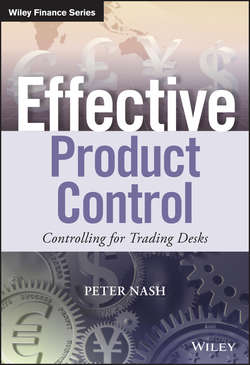Читать книгу Effective Product Control - Nash Peter - Страница 22
На сайте Литреса книга снята с продажи.
Part 1
Working in Product Control
CHAPTER 3
Key Stakeholders
Chief Operating Officers (COOs)
ОглавлениеChief operating officers (COOs), also known as business managers, assist the business in executing its strategy. Practically, this function brings together all the support functions in the end-to-end delivery of the business' products and services. Given this, product control will have a significant level of interaction with this function.
The COO can either report directly to the head of the business or to a global COO. For example, the ratesCOO could either report into the global head of the rates business or they could report into the global markets COO along with all the other COO's (e.g., credit, commodities, etc.).
The following describe some of the main functions COOs perform to fulfil their mandate.
System Infrastructure
COOs will assist the business by establishing and maintaining the necessary system infrastructure to continue trading and marketing existing products as well as establishing new products. Their functions are, for example, to:
• Monitor system performance and follow up on the remediation of issues such as system failures or delays, which could impact the desk.
• Provide the desk with the necessary system access to book trades, monitor risk and so on.
• Create new books or portfolios so that trades can be recorded in the bank's systems.
• Request new nostros (bank accounts) to enable the firm to settle transactions executed by the desk.
Onboarding New Products
When the business decide they want to trade or market a new product, the COO will launch new product proposals and facilitate the onboarding process. This can involve being the subject matter expert, or at the very least the point person that support functions can turn to for answers to any questions they have regarding the proposal.
Daily Operational Effectiveness
The COO monitors the key performance indicators (KPIs), which are a measure of how well the desk is performing operationally. The purpose of these collective checks is to gauge the level of operational risk that the desk are running. By reviewing multiple indicators, the COO can make a more informed assessment of this risk.
These KPIs will usually assess the following factors:
• Trade booking accuracy (late trades and trade amendments).
• Timely and accurate T+0 Flash (no late, missing or inaccurate estimates).
• Timely and complete P&L and risk report sign-offs.
• Complete and accurate end of day remarking.
• That the desk are trading within their product and risk mandate.
• The size, number and age of P&L adjustments.
• The size, number and age of cash breaks.
• The number and age of missing trade confirmations.
Forecasted Revenues, Costs, and Balance Sheet
The desk have targets for revenues, costs and balance-sheet usage. The COO will assist in developing these limits. Once created they will monitor the desk's relative performance against these levels.
Operational Risk Incident (ORI)
An ORI is simply an event where the control framework has failed. A bank will have risk and financial thresholds which will determine whether an ORI has taken place. When there is an ORI, the COO will involve themselves in the write-up of the event and assist in rolling out any key recommendations published by the operational risk team.
Implement Firm-Wide Changes
Often within banks, especially investment banks, the organization's structure can be changed in the hope that this brings with it higher operating profits. It is the COO who assists the desk in managing this change.
For example, the firm's senior management have decided to exit their structured-rates business; however, it is expected to take some time to exit all positions. To manage this effectively the firm has decided to create a legacy business unit. The structured rates desk will move from their current business unit into the legacy business unit. With this change comes the migration of all the static data (profit centres, trading books and any other organizational nodes), trades, P&L, balance sheet, costs and plans relating to structured rates. This change may sound simple but operationally it can be very difficult to execute.
